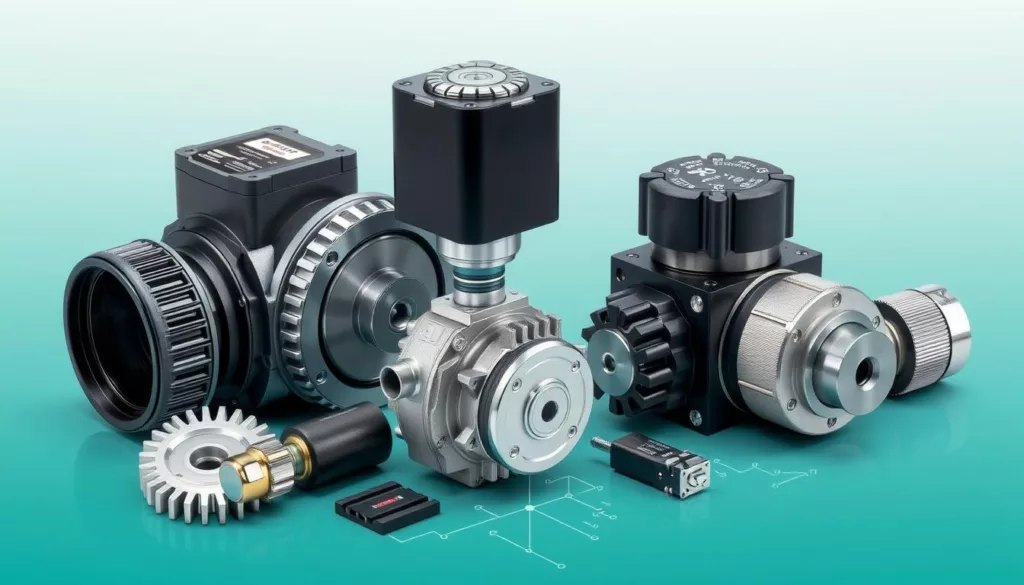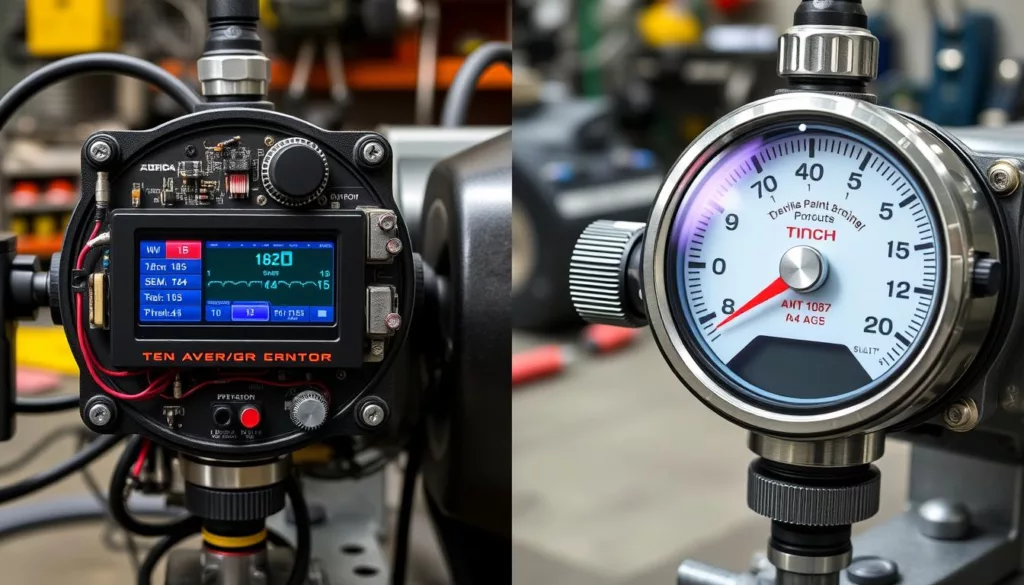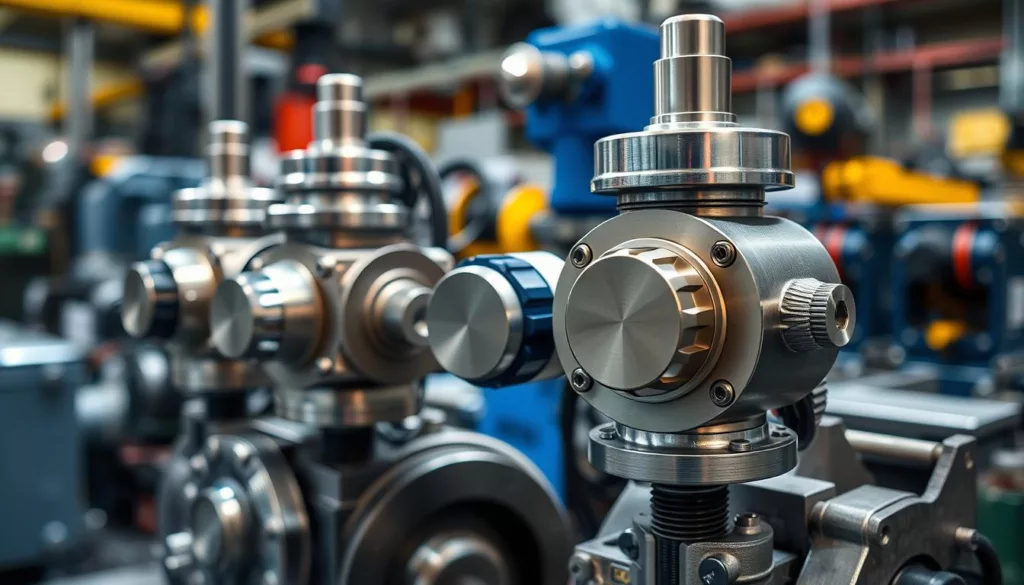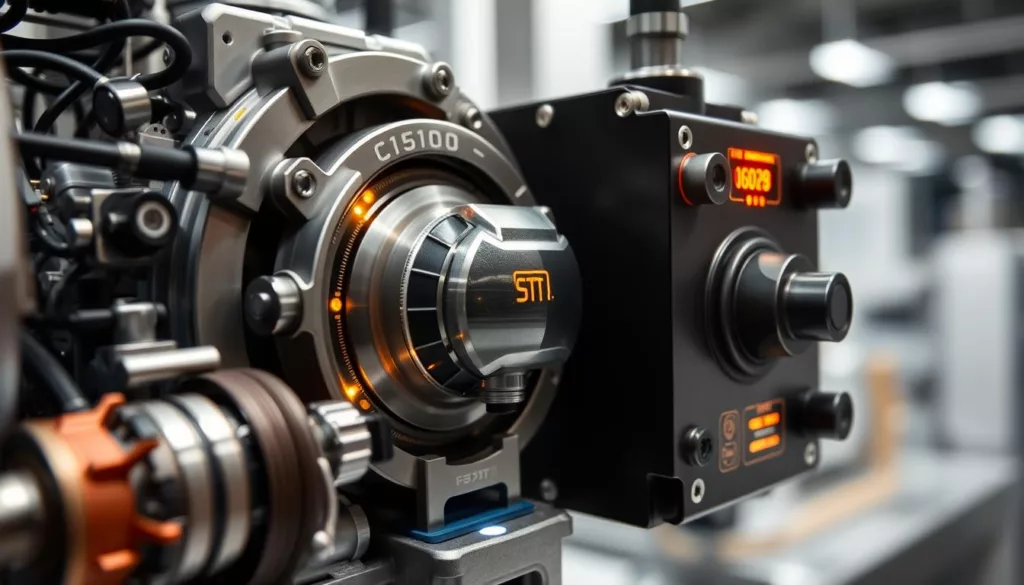The debate between digital and analog torque sensors has been ongoing for a long time. Both have their own strengths and fit different needs in various industries. At XJCSENSOR, we know how important it is to pick the right torque sensor for the best results.
Torque sensors are key in many fields, like car making and space exploration. They help keep mechanical systems safe and working well. Knowing the difference between digital and analog sensors can help you choose the right one for your job.
Key Takeaways
- Digital and analog torque sensors have their own benefits, like accuracy and ease of use.
- Choosing between them depends on what you need, like precision or quick response.
- Digital sensors are great for precise measurements and complex data handling.
- Analog sensors are cheaper and easier to use, perfect for simple tasks.
- Understanding the differences between digital and analog sensors helps you make a better choice for your system.
Understanding Torque Sensor Fundamentals
Torque sensors are key in many fields, like car making and space tech. They work based on basic principles of torque measurement. Knowing these basics helps us use industrial torque monitoring, precision torque sensing, and rotary torque sensors better.
Basic Principles of Torque Measurement
Torque is the force that makes things turn around a point. Torque sensors measure this force accurately. They use strain gauges to sense tiny changes in the sensor’s structure.
Key Components of Torque Sensing Systems
- Transducer: The main part that turns the torque into an electrical signal.
- Signal Conditioning: This part boosts, filters, and prepares the sensor’s signal for use.
- Data Acquisition: It captures, digitizes, and saves the torque data for analysis.
Evolution of Torque Sensing Technology
Torque sensing tech has grown a lot over time. It’s driven by the need for better precision, reliability, and integration. We’ve moved from old analog systems to new digital ones, always looking to improve.
“The evolution of torque sensing technology has been a testament to the relentless pursuit of precision and innovation in industrial applications.”
Core Technology Differences in Digital and Analog Sensors
Digital and analog sensors have key technology differences that affect their use. Knowing these differences helps choose the right sensor for your needs. This is true for the automotive industry, manufacturing, or research.
Signal Processing Methods
Digital torque sensors use advanced signal processing to turn electrical output into digital data. This data fits well with modern control systems and software. Analog sensors, by contrast, send out an electrical signal that matches the applied torque. This signal needs to be read by a separate system.
Data Conversion Techniques
Digital sensors convert their electrical signal into numbers using ADCs. This makes them easy to use with digital systems. Analog sensors send out a continuous signal that needs to be changed to digital for use in digital systems.
Response Time Characteristics
Digital sensors are quicker to respond than analog sensors. Their digital signal processing is set up for fast data handling. Analog sensors, though simpler, might be a bit slower because of their analog processing.
| Feature | Digital Torque Sensors | Analog Torque Sensors |
|---|---|---|
| Signal Processing | Advanced digital signal processing | Simpler analog circuitry |
| Data Conversion | Analog-to-digital conversion (ADC) | Continuous electrical output, requires external conversion |
| Response Time | Faster response times | Slightly slower response times |
Understanding these differences helps users pick the best torque sensor. This is for static torque measurement, dynamic torque applications, or automotive torque control.
Advantages of Digital Torque Sensors
Digital torque sensors stand out in the field of digital torque measurement and precision torque sensing. They outperform analog sensors in many areas, thanks to their advanced technology.
One key benefit is their high accuracy. Digital sensors use cutting-edge digital signal processing. This allows them to provide very precise torque readings. Such accuracy is vital in situations where small errors can have big impacts.
- Improved Noise Immunity: Digital torque sensors are less affected by electromagnetic interference (EMI) and other environmental factors. This means they give cleaner, more reliable data. This is important for precise measurements.
- Advanced Data Processing: Their digital nature lets them handle complex data processing. This includes real-time analysis and trend monitoring. Users can gain deeper insights and make better decisions with this data.
- Enhanced Connectivity: Digital torque sensors easily connect with modern control systems and data platforms. This makes them perfect for complex industrial settings. It helps in sharing data and improving system performance.
Digital torque sensors are becoming more popular for their high-precision digital torque measurement and precision torque sensing. They are used in many fields, from cars and manufacturing to research and development. These sensors are changing how industries handle important torque-based tasks.
“Digital torque sensors are revolutionizing the way we approach precision measurements, delivering unparalleled accuracy and versatility.”
Benefits of Analog Torque Sensors
Analog torque sensors are popular in certain industrial settings. They offer unique advantages. Knowing these benefits helps professionals choose the best technology for their needs.
Simplified Circuit Design
Analog torque sensors have simpler circuit designs than digital ones. This means they can save money. They need fewer parts and less wiring.
This is great for places where space or cost is important.
Cost-Effectiveness Factors
- Analog torque sensors are cheaper per unit. They’re good for large-scale analog torque transducers monitoring.
- They also need less maintenance and repairs. This saves money over time.
Reliability in Basic Applications
Analog torque sensors work well in simple applications. They’re perfect for industrial torque monitoring without advanced features. They give accurate readings without complex digital interfaces.
“Analog torque sensors are a smart choice for those who value simplicity and reliability in industrial torque monitoring tasks.”
Understanding analog torque sensors’ benefits helps professionals make better choices. These choices match their needs and budgets.
Precision and Accuracy Comparison
Digital and analog torque sensors have different levels of precision and accuracy. Let’s explore the main differences in their performance.
Digital torque sensors are known for their high precision. They provide accurate measurements with little change over time. Their advanced technology ensures consistent and reliable results, making them ideal for aerospace, robotics, and advanced manufacturing.
Analog torque sensors, while not as precise as digital ones, are simpler and more affordable. They are reliable for many industrial tasks. Their sturdy design and straightforward setup make them practical for basic machinery and power tools.
| Metric | Digital Torque Sensors | Analog Torque Sensors |
|---|---|---|
| Precision | Highly precise, with minimal drift | Adequate for many industrial applications |
| Accuracy | Highly accurate, with advanced signal processing | Suitable for static torque measurement |
| Repeatability | Excellent, with consistent results | Reliable, but may vary slightly |
| Noise Reduction | Advanced algorithms minimize interference | Adequate noise filtering, but not as advanced |
The choice between digital and analog torque sensors depends on the application’s needs. It’s about finding the right balance between precision, accuracy, cost, and complexity. Knowing the strengths and weaknesses of each helps professionals make the best choice for their projects.
Industrial Applications and Use Cases
Digital and analog torque sensors are used in many industrial settings. They are versatile and meet different needs. These technologies are key in the automotive, manufacturing, and research fields for precise torque measurements.
Automotive Industry Implementation
In the car world, automotive torque control is vital for performance and safety. Digital torque sensors are used to manage engines, transmissions, and steering. They offer quick and accurate data, essential for electric motors in hybrid cars.
Manufacturing Process Control
In manufacturing, torque sensors are key for quality and control. Both types are used to check and adjust torque in assembly and packaging. This helps keep production consistent and quality high.
Research and Development Applications
In research, torque sensors are essential for engineers and scientists. They help study dynamic torque applications and develop new tech. These sensors are vital in the automotive, aerospace, and industrial fields for innovation and understanding mechanical systems.
| Application | Preferred Sensor Type | Key Considerations |
|---|---|---|
| Automotive Industry | Digital Torque Sensors | Fast response time, accurate measurements, and compatibility with advanced electronic systems |
| Manufacturing Process Control | Both Digital and Analog Torque Sensors | Dependability, cost-effectiveness, and ease of integration with existing machinery |
| Research and Development | Digital Torque Sensors | Precise data acquisition, advanced data processing capabilities, and compatibility with data analysis software |
The need for better, smarter mechanical systems is growing. Torque sensors are becoming more important in these areas. Knowing the strengths of digital and analog sensors helps professionals improve their work and innovation.
Cost Analysis and ROI Considerations
Choosing the right industrial torque monitoring solution is all about cost. Both digital and analog torque sensors have different costs. It’s important to weigh these costs to get the best return on investment (ROI).
Digital torque sensors cost more upfront because of their advanced technology. But, they might save money in the long run. They need less upkeep and last longer. Plus, they give detailed data that can make processes more efficient, boosting ROI.
Analog torque sensors are cheaper to start with, which is good for those watching their budget. They are simple and easy to set up, making them cost-effective for basic needs. They also need less maintenance, which saves money over time.
| Cost Factors | Digital Torque Sensors | Analog Torque Sensors |
|---|---|---|
| Initial Investment | Higher | Lower |
| Maintenance Costs | Lower | Higher |
| Operational Lifespan | Longer | Shorter |
| Data Insights | Advanced | Basic |
Choosing between digital and analog torque sensors depends on a detailed cost analysis. Consider the application’s needs, budget, and desired performance and data insights.
Integration and Compatibility Features
When you add digital torque sensors and analog torque sensors to your systems, several important things matter. You need to think about software needs, hardware fit, and how to connect them. Knowing these details is key for a smooth setup.
Software Requirements
Digital torque sensors need special software to work right. They send out digital signals that need special tools to understand and use. On the other hand, analog sensors are easier to connect with common industrial software because they send out simple signals.
Hardware Integration Challenges
Adding rotary torque sensors to your setup can be tricky. Digital sensors might need more complicated wiring and adapters to fit with old equipment. But, analog sensors are often easier to plug in, making them a quicker choice for hardware setup.
System Connectivity Options
- Digital torque sensors can connect in many ways, like Ethernet, USB, and wireless. This makes them great for modern systems.
- Analog torque sensors usually connect with wires, like voltage or current outputs. This is common in industrial settings.
Choosing between digital and analog torque sensors depends on your system’s needs. Think about your software, hardware, and how you want to connect them. Picking the right one can make your setup work smoothly.
Conclusion
Digital and analog torque sensors each have their own strengths. Digital sensors are great for precise measurements and work well with modern systems. Analog sensors are simpler, cheaper, and reliable for basic tasks.
Choosing between which is better? depends on what you need. Think about accuracy, how fast it responds, how it fits with your system, and your budget. These factors help decide the best sensor for you.
Knowing the differences between digital and analog sensors helps professionals make better choices. This knowledge ensures they meet their needs and goals. It’s a key part of using torque sensor technology effectively in many industrial settings.






